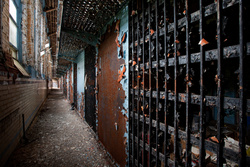
The exhibition comprises the complete sets of the first and second edition of Piranesi’s Carceri from the National Gallery of Victoria collection, and Vik Muniz’s series of eight photographs after Piranesi’s Prisons on loan from Sikkema Jenkins Gallery, New York. His large photographs invite the viewer to look anew at Piranesi’s iconic images, and simultaneously, to explore Muniz’s artful constructions.

the Interior of the Coliseum, from Le Antichita Romane de G.B. A photograph of these constructions is the end product of Muniz’s work. Shop for great deals on Giovanni Battista Piranesi Posters for. Piranesis most famous series and next to the Black Paintings by Francisco Goya is considered one of the most mysterious works of the. In his Prisons, after Piranesi series Muniz replicates the etched lines of the Prison images with thread, which is wound around hundreds of pins on a cardboard surface. Muniz works between drawing and photography, recreating iconic images from the work of past masters including Rembrandt, Goya and Piranesi in a range of unusual but significant media, such as chocolate, sugar, dust, wire and string. This exhibition brings together the first and second edition of Piranesi’s Prison series with eight photographs made in 2002 by the Brazilian-born, New York based artist Vik Muniz.
#G. b. piranesi prison full#
Returning to the series a decade later Piranesi substantially reworked the images, transforming the loose, lightly etched prints of the first edition into darker images full of shadows, torture instruments and prisoners. Piranesi’s innovative approach to the medium of etching is matched by his formal investigations into the representation of pictorial space, resulting in compositions that revel in ambiguity. As the title of the series suggests, the prints represent views of imaginary prisons, depicted as vast yet claustrophobic environments populated by tiny figures. The breathtaking originality of Giovanni Battista Piranesi’s dramatic series of etchings, the Imaginary Prisons (Carceri d’invenzione), has remained a source of inspiration and fascination for artists, writers and architects since they were first published in Rome in the mid-eighteenth century.


 0 kommentar(er)
0 kommentar(er)
